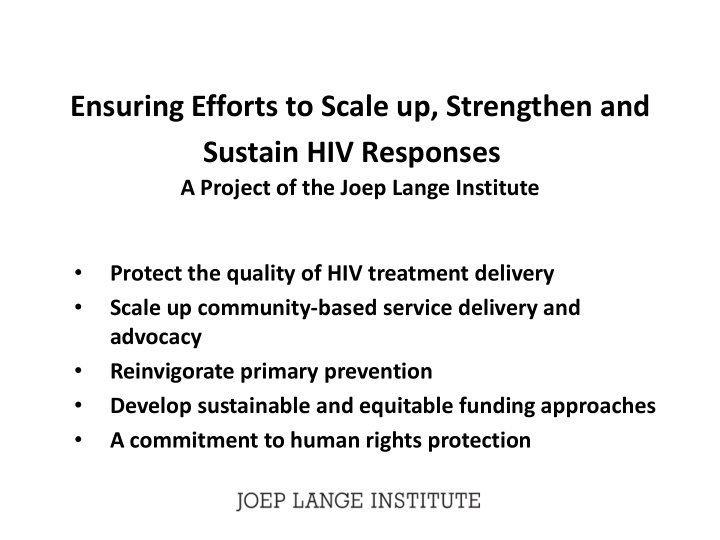



Ensuring Efforts to Scale up, Strengthen and Sustain HIV Responses A Project of the Joep Lange Institute • Protect the quality of HIV treatment delivery • Scale up community-based service delivery and advocacy • Reinvigorate primary prevention • Develop sustainable and equitable funding approaches • A commitment to human rights protection
Funding for the Global HIV Response • Funding has not met estimate needs as described in the Fast Track initiative • Middle-income countries, where the majority of people with HIV live, are not able or willing to fill the gap from external donor withdrawal • Key populations remain underserved and underfunded
Resources available in 2014 and resources required from 2015 – 2030 by level of income in low- and middle-income countries (according to 2015 WB income level classification) Stover J, Bollinger L, Izazola JA, Loures L, DeLay P, et al. (2016) What Is Required to End the AIDS Epidemic as a Public Health Threat by 2030? The Cost and Impact of the Fast-Track Approach. PLOS ONE 11(5): e0154893. https://doi.org/10.1371/journal.pone.0154893 http://journals.plos.org/plosone/article?id=10.1371/journal.pone.0154893
Backdrop: Declining donor support Donor Government Disbursements for HIV, 2002-2016 US$ Billions $8,6216 $8,4875 $7,8820 $7,7773 $7,7029 Current $7,6471 $7,4644 $6,9535 $6,8838 Constant (2014$) $5,0038 $3,9165 $3,5105 $2,8080 $1,6066 $1,2063 2002 2003 2004 2005 2006 2007 2008 2009 2010 2011 2012 2013 2014 2015 2016 SOURCES: UNAIDS and Kaiser Family Foundation analyses; Global Fund to Fight AIDS, Tuberculosis and Malaria online data queries; UNITAID Annual Reports and direct communication; OECD CRS online data queries.
What happens to HIV outcomes when funding falls short of need?
Source: Funders Concerned About AIDS, 2017
Develop HIV-inclusive UHC platforms and schemes • HIV treatment and prevention should be included in UHC-driven insurance schemes as quickly as feasible. • The Global Fund, World Bank and other donors should consider funding all aspects of comprehensive HIV care through UHC schemes to allow those schemes to stabilize as they grow. • UHC must include more than access to health and treatment services, as coverage for prevention interventions is vital. • Any UHC scheme must include key and marginalized populations if it is to succeed and be truly universal. • High drug prices in middle-income countries could undermine the stability of UHC schemes. Access to generic medications and/or reduced pricing should be extended to MICs if their UHC goals are to be met. • Community advocates should be involved in all aspects of UHC program development, implementation and monitoring.
Prevent a resurgence of HIV in middle-income countries (MICs) • The UN should develop transparent measurements of progress on sustainable development that go beyond per capita income. These should recognize poverty in all of its forms and dimensions and the economic, social and environmental dimensions of domestic output and structural gaps at all levels. Additional criteria to be considered could include fiscal space, economic growth, health spending, inequality, willingness to pay, debt to gross domestic product (GDP) ratio, etc. • Governments should not assume that external financing will always be available and thus they should begin transition planning as soon as possible. As they reduce dependency on external donors, they should prioritize efforts to allocate adequate levels of domestic funding to address HIV and other health needs, including those of key populations. • The Global Fund and other donors should develop bridge funding mechanisms for MICs facing transition as one option. But the concept of ‘bridge’ might not be sufficient in places where the other end of the metaphorical bridge, domestic financing and support, is uncertain or unlikely. The funding and support strategies and approaches implemented should be designed to be used and prioritized for as long as the gaps exist, regardless of how long that might take. • Donors also should jointly agree on strategies to support CBOs and other civil society groups in such countries not only to sustain what was started by the Global Fund and others, but to preserve progress made to date and expand and strengthen it. Such funding should include support for advocacy to encourage transition planning and implementation.
Three important overarching points about collaboration, integration and acting on evidence: • Continued progress cannot be made on HIV, with or without UHC platforms in place, unless there is sufficient money for prevention and other key non-treatment services upfront. Supporting a robust ‘infrastructure for prevention’ will require integrating non-state actors in ways that allow them to grow while retaining the independent, separate qualities that make them effective. • South-South cooperation and learning should be emphasized and supported . The extensive and impressive work at local levels around the world is often poorly recognized or highlighted. For example, there is much that other countries can learn from their counterparts’ experiences in designing and implementing a range of financing mechanisms that aim to expand and sustain HIV responses. There is space for valuable lessons both negative and positive, and from countries with small, concentrated epidemics as well as those with, large generalized ones. • More research and analysis are needed to answer some of the important questions around community-based services, DSD and integration . Evidence and data can help to better determine, for example, the strengths and weaknesses of specific HIV interventions provided by CBOs in a range of settings; which DSD models work best; and the effect of integration of HIV into primary care on the quality of HIV services.
Recommend
More recommend